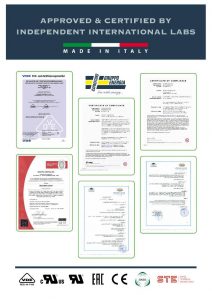
When designing a power factor correction panel, it is very important to choose connection cables that are suitable for supporting the system currents.
Choosing an insufficient cable section may lead to overheating of the entire system, which therefore drastically reduces the life of all the components.
Below you can find some simple tips that will allow you to make the correct electrical connections for your power factor correction capacitor banks.
1. The cable cross section must be selected according to the operating voltage (V) and power (kVar) of capacitors.
For more information, please consult the table below:
| Capacitor power (kVar) | Cable size (mm2) | |||||
| 230 V / 240 V | From 400 V to 525 V | From 600 V to 750 V | ||||
| Al* | Cu** | Al | Cu | Al | Cu | |
| 2,5 | 4 | 4 | 4 | 4 | 4 | 4 |
| 5 | 6 | 6 | 6 | 6 | 6 | 6 |
| 6,25 | 10 | 6 | 6 | 6 | 6 | 6 |
| 7,5 | 10 | 6 | 6 | 6 | 6 | 6 |
| 10 | 16 | 10 | 6 | 6 | 6 | 6 |
| 12,5 | – | – | 10 | 6 | 6 | 6 |
| 15 | – | – | 10 | 6 | 6 | 6 |
| 20 | – | – | 16 | 10 | 10 | 6 |
| 25 | – | – | 25 | 16 | 16 | 10 |
| 30 | – | – | – | 25 | 16 | 10 |
| 40 | – | – | – | 35 | 25 | 16 |
| 50 | – | – | – | 35 | 35 | 25 |
| 75 | – | – | – | 2 x 35 | 2 x 25 | 35 |
| 100 | – | – | – | 2 x 35 | 2 x 35 | 2 x 25 |
*Aluminum Unipolar Cable.
**Copper Unipolar Cable.
2. Carefully select a cable temperature withstand capacity which does not drop below 90 ºC for most applications.
3. Always use suitable size lugs for the connecting cable. By using cables without lugs you might cause heat generation due to improper contacts, therefore reducing the life of the electric equipment.
4. Remove the insulation from the cable conductor only for the necessary length for an appropriate connection of lug.
5. Make sure that no single strand comes out from the lug, and then insert the conductor fully in the terminal.
6. We recommend using a pneumatic gun from the top of the terminal cover in order to tighten the screw.
If you have only a screw driver, please make sure that is properly tightened:
For MT 16 terminals tightening torque is 1,3 Nm.
For MT 25 terminals tightening torque is 2,5 Nm.
For MT 35 terminals tightening torque is 3,0 Nm.
7. If you want to connect more capacitors in parallel, do it as you can see in our Instagram post.

